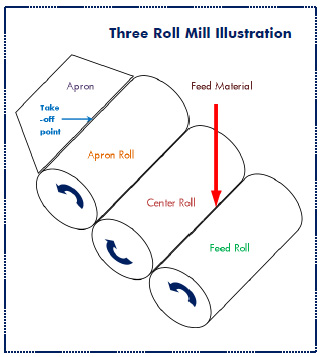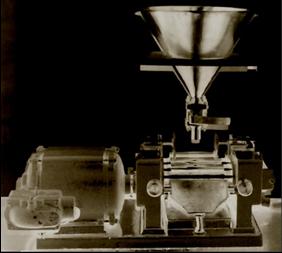Tech Report
Create smooth, speck-free pastes in your Three Roll Mill.

Technology Brief
Across the process industries, Three Roll Mills are used to achieve a high quality dispersion in pastes, gels and other semi-solids. Suitable applications include medium to high viscosity materials that cannot be adequately dispersed in conventional high speed mixers.
Basic operating theory of Three Roll Mills
A Three Roll Mill is composed of three horizontally positioned rolls rotating in opposite directions and at different speeds. The material to be milled is placed between the feed and center rolls, quickly adhering to the rotating surfaces and spreading out evenly. Shear forces between the adjacent rolls break up the agglomerates in the product. When the apron roll is engaged, the material transfers to it while being subjected to additional shear forces at even higher intensities.
The distance between each roll is adjustable and impacts both shear level and throughput. Gap settings in the range of 0.001" are common.
Milled material is scraped from the apron roll by a take-off knife. The cycle can be repeated to improve dispersion quality or until an equilibrium particle size distribution is reached.
Paste production in a Three Roll Mill

Viscous materials such as pastes, creams, gels and other semi-solids are ideal applications for the Three Roll Mill. Such products may often undergo a two-stage process, starting in a conventional batch mixer where all the raw ingredients are combined, often at an elevated temperature. Following a cool down phase, the pre-mix material is fed to the Three Roll Mill to achieve the desired dispersion or to eliminate any visual specks or imperfections in the final product.
Stubborn agglomerates (like that of certain pigments, i.e. phthalo green, quinacridone violet, phthalo blue) in sticky, paste-like vehicles are particularly difficult to disperse using traditional agitators, including those that run at relatively high tip speeds such as saw-tooth dispersers and rotor/stator mixers. These devices are fairly limited in terms of viscosity range to produce adequate flow in a mixing vessel, it is commonly necessary to increase operating temperature so the material is at a more workable viscosity. Heat-sensitive applications therefore benefit from alternative processing methods such as the low temperature/high shear conditions that Three Roll Mills provide.
Three Roll Mills remain to be one of the best equipment for preparing very fine particle dispersions in paints, inks, plastisols, cosmetics, pharmaceuticals, electronic coatings, dental composites, ceramics and other applications. It does require a skilled operator not only to produce consistent results but also to run the mill safely. Testing is recommended to determine the ideal gap settings for a particular product in order to optimize both dispersion quality and throughput.
Sample Application: Antibiotic Ointment

A pharmaceutical company specializing in semi-solid and liquid over-the-counter products is using a Ross 4" x 8" Three Roll Mill for their line of antibiotic ointment creams.
The manufacturing process starts with heating a petrolatum base to 185°F and mixing in the first active ingredient using a saw-tooth disperser blade. In another tank, a triglyceride base is melted to around 110oF and a second active ingredient is added to it in the same manner.
Material from the first tank is allowed to cool to 110°F and then combined with the triglyceride batch. Despite being subjected to high speed mixing, the resulting pre-mix contains visible flecks and particles. Two passes through the Three Roll Mill produces a visibly smooth, speck-free cream. Product temperature is kept stable by running cooling water through the cored rolls.